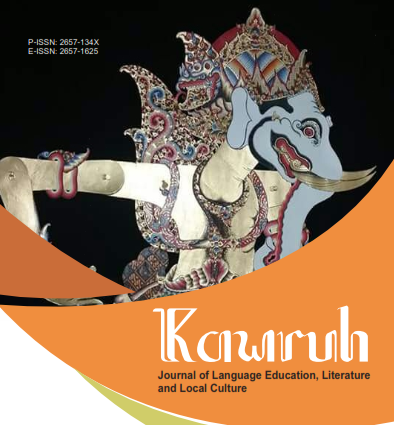Women's Struggle Against Patriarchy in the Novel Katresnan by Soeratman Sastradihardja from the Perspective of Liberal and Radical Feminism
DOI:
https://doi.org/10.32585/kawruh.v7i1.6201Keywords:
Patriarchy, Feminism, Gender injustice , Javanese novel , ResistanceAbstract
This study aims to provide an in-depth understanding of literature as a medium for expressing social criticism, particularly regarding gender injustice in the novel Katresnan by Soeratman Sastradihardja. The deeply rooted patriarchal culture in Indonesian society has long been a source of gender inequality, especially as reflected in literary works that mirror social realities. This research focuses on how the female characters in the novel confront and resist patriarchal domination. This is a qualitative descriptive study using a literature review method. The primary data source is the novel Katresnan by Soeratman Sastradihardja, published by Balai Pustaka, consisting of 89 pages. The research data comprise narrative passages and dialogues in the novel, collected through reading and note-taking techniques, and analyzed using liberal and radical feminist approaches. The findings reveal that the character Mursiati resists patriarchal values through her struggles for education, career, and rejection of forced marriage. The liberal feminist perspective emphasizes Mursiati’s individual struggle for freedom and the right to choose, while the radical feminist approach highlights the systemic social structures that oppress women. Katresnan reflects gender inequality and offers social criticism of patriarchal culture, representing feminist aspirations within regional literature. This study is expected to enrich feminist literary studies in regional contexts and encourage critical readings of patriarchal culture in Indonesian literature.
Downloads
References
Alfatih, Andy. (2023). Buku Pedoman Mudah Melaksanakan Penelitian Kualitatif.
Aulia, Rifa, Yusro Edy Nugroho, and Teguh Supriyanto. (2024). “Analisis Feminisme Liberal Pada Tokoh Utama Dalam Novel ‘Amba’Karya Laksmi Pamuntjak.” Lingua Rima: Jurnal Pendidikan Bahasa Dan Sastra Indonesia 13 (1): 189–200. https://jurnal.umt.ac.id/index.php/lgrm/article/view/11072.
Beauvoir, Simone De. 1956. The Second Sex. Jonathan Cape.
Fakih, Mansour. (2008). Analisis Gender Dan Transformasi Sosial. INSISTPress.
Kusuma, Shella Nada, Yuli Kurniati Werdiningsih, and Sunarya Sunarya. (2021). “Peran Perempuan Dalam Novel Cinencang Lawe Karya Tulus Setiyadi Kajian Feminisme.” JISABDA: Jurnal Ilmiah Sastra Dan Bahasa Daerah, Serta Pengajarannya 2 (2): 63–72. https://doi.org/10.26877/jisabda.v2i2.7819.
Murdaningrum, Sekar Wulan, and Ari Prasetiyo. (2019). “Perjuangan Menghadapi Objektifikasi Perempuan Dalam Novel Astirin Mbalela Karya Suparto Brata.” Journal of Chemical Information and Modeling 15 (2): 9–25.
Murenda, Everyana, and Darni. (2020). “Citrane Wanita Mandhiri Sajrone Novel Kendhaga Benthet Anggitane Tulus Setiyadi.” JOB (Jurnal Online Baradha.
Nugroho, Yusro Edy. (2023). “The Transition Of Women’s Ideology In Modern Javanese Literature.” Jurnal Javanologi 6 (2): 1238. https://doi.org/10.20961/javanologi.v6i2.75120.
Nuraeni, Rani. (2017). “Feminisme Dalam Novel Perempuan Berkalung Sorban Karya Abidah El Khaliqy.” Diksatrasia: Jurnal Ilmiah Pendidikan Bahasa Dan Sastra Indonesia 1 (2): 124–32. https://doi.org/10.25157/diksatrasia.v1i2.590.
Putri, Clarisa Septiani, Suci Sundusiah, and Dheka Dwi Agustiningsih. (2022). “Representasi Tokoh Perempuan Dalam Novel Rapijali 1: Mencari Karya Dee Lestari.” Artikulasi: Jurnal Pendidikan Bahasa Dan Sastra Indonesia 2 (2): 101–7. https://doi.org/10.17509/artikulasi.v2i2.68469.
Rofiqoh, Rieskie Ari, Nuning Zaidah, and Yuli Kurniati Werdiningsih. (2021). “Kekerasan Terhadap Perempuan Dalam Novel Kupu Wengi Mbangun Swarga Karya Tulus Setiyadi (Kajian Feminisme Sastra).” JISABDA: Jurnal Ilmiah Sastra Dan Bahasa Daerah, Serta Pengajarannya 2 (2): 31–43. https://doi.org/10.26877/jisabda.v2i2.7747.
Rosita, Andjelina Putri, and Bambang Sulanjari. (2023). “Citra Perempuan Jawa Dalam Novel ‘Sindhen Padmi’ Karya Tulus Setyadi: Kajian Feminisme.” Kaloka: Jurnal Pendidikan Bahasa Dan Sastra Daerah 2 (1): 1–10. https://doi.org/10.26877/kaloka.v2i1.10824.
Sastradihardja, S. (2013). Katresnan. Kiblat.
Tyas, Ajeng Ayuning. (2021). “Kajian Feminisme Dalam Novel ‘Bumi Manusia’ Karya Pramoedya Ananta Toer.” Jurnal Simki Pedagogia 4 (2): 159–68. https://doi.org/10.29407/jsp.v4i2.45.
Wafik, Fahrani, and Nani Solihati. (2022). “Feminisme Radikal Dalam Novel Perempuan Yang Menangis Kepada Bulan Hitam Karya Dian Purnomo.” Asas: Jurnal Sastra 11 (2): 66. https://doi.org/10.24114/ajs.v11i2.37153.
Walby, Silvia. (1990). Theorizing Patriarchy. Environment and Planning A: Economy and Space. Vol. 26.
Zed, Mestika. (2008). Metode Penelitian Kepustakaan. Yayasan Obor Indonesia. Yayasan Obor Indonesia.
Zuhri, Saifuddin, and Diana Amalia. (2022). “Ketidakadilan Gender Dan Budaya Patriarki Di Kehidupan Masyarakat Indonesia.” Murabbi: Jurnal Ilmiah Dalam Bidang Pendidikan 1 STIT Al-Hikmah Tebing Tinggi 5 (1): 17–41.
Downloads
Published
How to Cite
Issue
Section
License
Copyright (c) 2025 Rina Yuliana, Herlina Setyowati, Aris Aryanto

This work is licensed under a Creative Commons Attribution-ShareAlike 4.0 International License.
Authors who publish with the Kawruh: Journal of Language Education, Literature and Local Culture agree to the following terms:
- Authors retain copyright and grant the journal the right of first publication with the work simultaneously licensed under a Creative Commons Attribution License (CC BY-SA 4.0) that allows others to share the work with an acknowledgment of the work's authorship and initial publication in this journal.
- Authors are able to enter into separate, additional contractual arrangements for the non-exclusive distribution of the journal's published version of the work (e.g., post it to an institutional repository or publish it in a book), with an acknowledgment of its initial publication in this journal.
- Authors are permitted and encouraged to post their work online (e.g., in institutional repositories or on their website) prior to and during the submission process, as it can lead to productive exchanges, as well as earlier and greater citation of published work.

